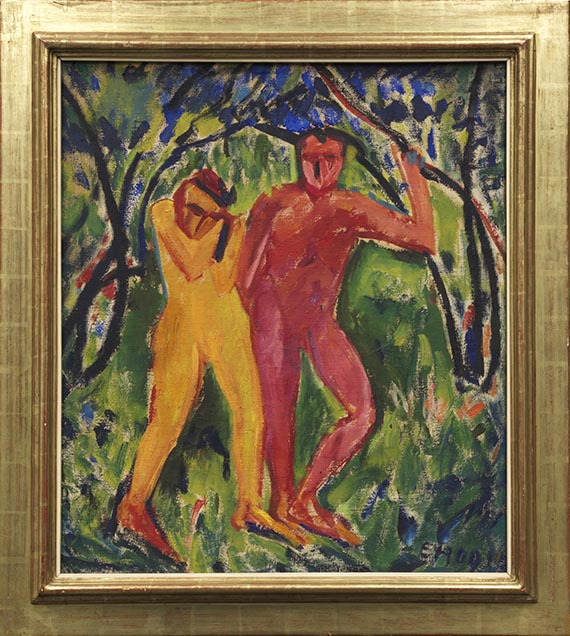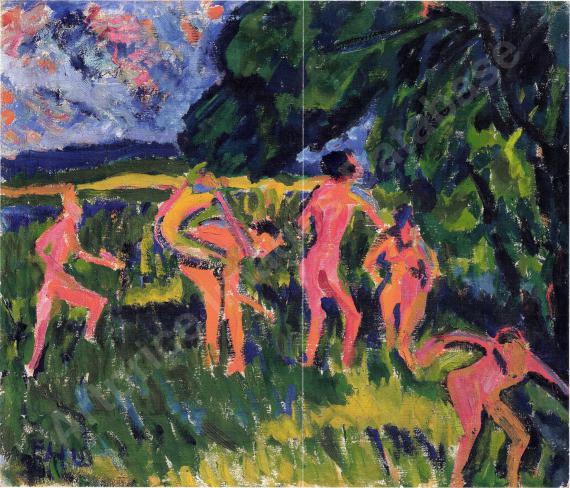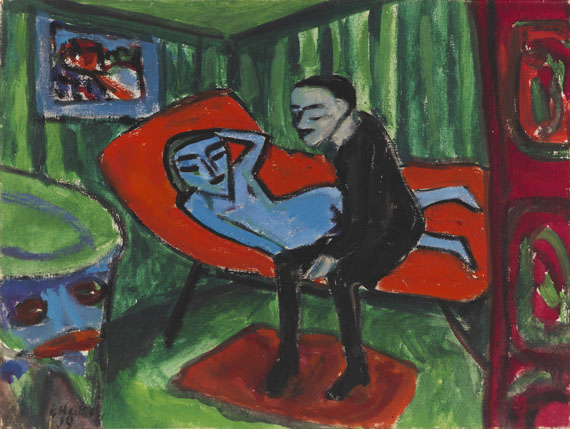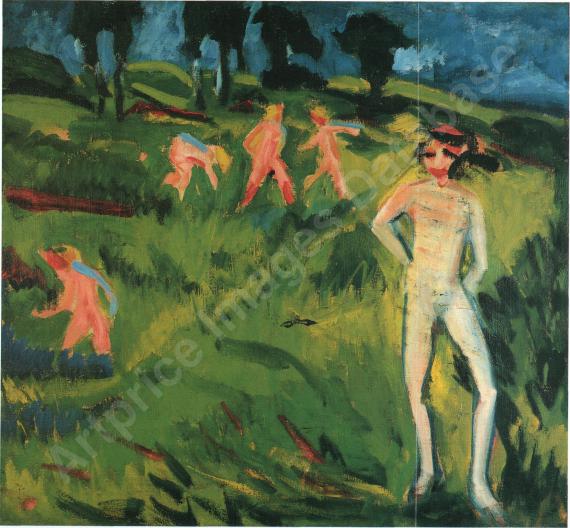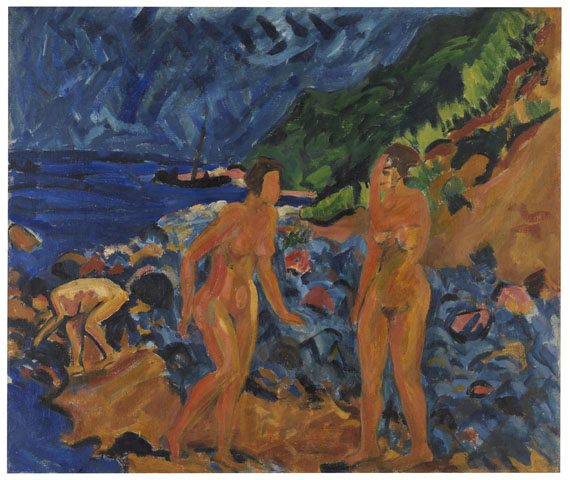124000041
Erich Heckel
Zwei Menschen im Freien, 1909/10.
Olio su tela
Stima: € 400,000 / $ 428,000
Le informationi sulla commissione, le tasse e il diritto di seguito saranno disponibili quattro settimane prima dell´asta.
Zwei Menschen im Freien. 1909/10.
Oil on canvas.
Lower right monogrammed andd ated. Signed and dated on the reverse of the canvas. On the reverse of the stretcher signed, titled and dated "Zwei Menschen im Freien 1909", numbered "16" and "221 / E", as well as with exhibition labels. 81 x 70 cm (31.8 x 27.5 in).
[KT].
• From the "Brücke" heyday, when the artists created their most important nudes on the Moritzburg Ponds.
• The pinnacle of the group's collaborative activities.
• The immediacy of the informal depiction of nudes in untouched nature is one of the guiding principles of "Brücke" art.
• The painting "Im Wald" by Ernst Ludwig Kirchner from the same period as Erich Heckel's "Zwei Menschen im Freien" is also part of this auction.
PROVENANCE:
From the artist's estate, Hemmenhofen.
Galerie Roman Norbert Ketterer, Campione d'Italia (1965).
Galleria Henze, Campione d'Italia (1983).
Private collection Italy.
EXHIBITION:
Erich Heckel, Werke der Brückezeit 1907-1917, Württembergischre Kunstverein, Stuttgart September 15 - October 27, 1957, no. 16.
Erich Heckel, Galerie Wolfgang Ketterer, Muüinch, Hanover, Campione d'Italia, February 26 - April 17, 1966, no. 63.
Moderne Kunst VI, Galerie Roman Norbert Ketterer, Campione d'Italia, 1969, no 22.
Künstler der Brücke an den Moritzburger Seen 1909-1911, Brücke-Museum, Berlin, October 1 - December 15, 1970, no. 34.
Erich Heckel. Galerie Roman Norbert Ketterer, Campione d'Italia, 1970, no. 2.
Erich Heckel zum 90. Geburtstag, Galerie Roman Norbert Ketterer, Campione d'Italia, 1973, no. 2.
Erich Heckel, Galleria Henze, Campione d'Italia, 1983, no. 2.
Erich Heckel, Museum Folkwang, Essen, September 18 - November 20, 1983, no. 16.
Futurismo & Futurismi, 13. Biennale di Venezia, Palazzo Grassi, Venice, May 4 - October 12, 1986, no. 769 (with the label).
Figures du moderne, L'expressionisme en allemagne 1905-1914, Musée d'art moderne de la ville de Paris, Paris, November 18 - March 14, 1992, no. 3 (with the label).
Künstler der Brücke in Moritzburg, Museum Schloß Moritzburg, Moritzburg bei Dresden, July 1 - October 1, 1995, no. 37.
The Romantic Spirit in German Art 1790 - 1990, Scottish National Gallery of modern art, Edinburgh, July 28 - September 7, 1994, no. 137 (with the label on the frame).
Ernste Spiele, Der Geist der Romantik in der deutschen Kunst 1790-1990, Haus der Kunst, Munich, February 4 - May 1, 1995, no. 212.
Paul Gauguin. Das verlorene Paradies, Museum Folkwang, Essen, June 17 - October 18, 1998; Neue Nationalgalerie, Berlin, October 31 - January 10, 1999, no. E2.
Die Badenden, Mensch und Natur im deutschen Expressionismus, Kunsthalle, Bielefeld, September 3 - November 19, 2000, no. 37.
Die Brücke in Dresden 1905-1911, Galerie Neue Meister, Dresden, October 20, 2001 - January 6, 2002, no. 265.
Femme fatale. il mito universale della donna nell’arte da Modigliani a Warhol, Villa Ponti, Arona, July 31 - November 7, 2004 (with the label on the frame).
El Nacimiento del Espresionismo Alemán, Museo Thyssen-Bornemisza, Madrid, February 1 - May 15, 2005; El naixement de l'expressionisme, Museu Nacional d'Art de Catalunya, Barcelona, June 2 - September 4, 2006, no. 157.
100 Jahre Expressionismus, Neue Nationalgalerie, Berlin, June 8 - August 28, 2005, no. 166.
LITERATURE:
Andreas Hüneke, Erich Heckel. Werkverzeichnis der Gemälde, Wandbilder und Skulpturen, vol. I: 1904-1918, p. 111, no. 1910-42 (illu.).
Paul Vogt, Erich Heckel, Recklingshausen 1965, p. 1909, no. 1909-14 (illu.).
---
Leopold Reidemeister, Brücke Archive issue 4: Erich Heckel zum Dank und Gedenken, Berlin 1970, p. 18.
Anton Henze, Erich Heckel, Leben und Werk, Stuttgart/Zürich 1983, p. 42.
Jill Lloyd, German Expressionism. Primitivism and Modernity, New Haven/London 1991, no. 143.
Oil on canvas.
Lower right monogrammed andd ated. Signed and dated on the reverse of the canvas. On the reverse of the stretcher signed, titled and dated "Zwei Menschen im Freien 1909", numbered "16" and "221 / E", as well as with exhibition labels. 81 x 70 cm (31.8 x 27.5 in).
[KT].
• From the "Brücke" heyday, when the artists created their most important nudes on the Moritzburg Ponds.
• The pinnacle of the group's collaborative activities.
• The immediacy of the informal depiction of nudes in untouched nature is one of the guiding principles of "Brücke" art.
• The painting "Im Wald" by Ernst Ludwig Kirchner from the same period as Erich Heckel's "Zwei Menschen im Freien" is also part of this auction.
PROVENANCE:
From the artist's estate, Hemmenhofen.
Galerie Roman Norbert Ketterer, Campione d'Italia (1965).
Galleria Henze, Campione d'Italia (1983).
Private collection Italy.
EXHIBITION:
Erich Heckel, Werke der Brückezeit 1907-1917, Württembergischre Kunstverein, Stuttgart September 15 - October 27, 1957, no. 16.
Erich Heckel, Galerie Wolfgang Ketterer, Muüinch, Hanover, Campione d'Italia, February 26 - April 17, 1966, no. 63.
Moderne Kunst VI, Galerie Roman Norbert Ketterer, Campione d'Italia, 1969, no 22.
Künstler der Brücke an den Moritzburger Seen 1909-1911, Brücke-Museum, Berlin, October 1 - December 15, 1970, no. 34.
Erich Heckel. Galerie Roman Norbert Ketterer, Campione d'Italia, 1970, no. 2.
Erich Heckel zum 90. Geburtstag, Galerie Roman Norbert Ketterer, Campione d'Italia, 1973, no. 2.
Erich Heckel, Galleria Henze, Campione d'Italia, 1983, no. 2.
Erich Heckel, Museum Folkwang, Essen, September 18 - November 20, 1983, no. 16.
Futurismo & Futurismi, 13. Biennale di Venezia, Palazzo Grassi, Venice, May 4 - October 12, 1986, no. 769 (with the label).
Figures du moderne, L'expressionisme en allemagne 1905-1914, Musée d'art moderne de la ville de Paris, Paris, November 18 - March 14, 1992, no. 3 (with the label).
Künstler der Brücke in Moritzburg, Museum Schloß Moritzburg, Moritzburg bei Dresden, July 1 - October 1, 1995, no. 37.
The Romantic Spirit in German Art 1790 - 1990, Scottish National Gallery of modern art, Edinburgh, July 28 - September 7, 1994, no. 137 (with the label on the frame).
Ernste Spiele, Der Geist der Romantik in der deutschen Kunst 1790-1990, Haus der Kunst, Munich, February 4 - May 1, 1995, no. 212.
Paul Gauguin. Das verlorene Paradies, Museum Folkwang, Essen, June 17 - October 18, 1998; Neue Nationalgalerie, Berlin, October 31 - January 10, 1999, no. E2.
Die Badenden, Mensch und Natur im deutschen Expressionismus, Kunsthalle, Bielefeld, September 3 - November 19, 2000, no. 37.
Die Brücke in Dresden 1905-1911, Galerie Neue Meister, Dresden, October 20, 2001 - January 6, 2002, no. 265.
Femme fatale. il mito universale della donna nell’arte da Modigliani a Warhol, Villa Ponti, Arona, July 31 - November 7, 2004 (with the label on the frame).
El Nacimiento del Espresionismo Alemán, Museo Thyssen-Bornemisza, Madrid, February 1 - May 15, 2005; El naixement de l'expressionisme, Museu Nacional d'Art de Catalunya, Barcelona, June 2 - September 4, 2006, no. 157.
100 Jahre Expressionismus, Neue Nationalgalerie, Berlin, June 8 - August 28, 2005, no. 166.
LITERATURE:
Andreas Hüneke, Erich Heckel. Werkverzeichnis der Gemälde, Wandbilder und Skulpturen, vol. I: 1904-1918, p. 111, no. 1910-42 (illu.).
Paul Vogt, Erich Heckel, Recklingshausen 1965, p. 1909, no. 1909-14 (illu.).
---
Leopold Reidemeister, Brücke Archive issue 4: Erich Heckel zum Dank und Gedenken, Berlin 1970, p. 18.
Anton Henze, Erich Heckel, Leben und Werk, Stuttgart/Zürich 1983, p. 42.
Jill Lloyd, German Expressionism. Primitivism and Modernity, New Haven/London 1991, no. 143.
If one wanted to describe a Brücke style in a narrow sense, works created in the Dresden studios of Heckel and Kirchner or in context of their the excursions to the Moritzburg Ponds, in which Pechstein and Otto Mueller also participated, are at the heart of it. The atmosphere of the artistic activity becomes manifest not only through the shared sitters, it is the exchange of common ways of life, the indispensable curiosity for the aesthetics of the unfamiliar, for the beauty of the new, which made the Brücke artists the reformers and spectres of a painting style prevalent at the academies all over the country at the time.
And the paintings "Zwei Menschen im Freien" (Two People Outdoors) by Heckel and Kirchner's scenic depiction of an astonishingly grotesque encounter "Im Wald" (In the Forest) are an almost obvious confirmation of a charged atmosphere of artistic activity. An encounter, then and now, in a spontaneous form of painting, a richness of color full of warm tones, a unifying theme in an unspoiled nature, a reflection of an experience that all made the same way.
It is their painterly language that expresses something 'wild', impetuous, reveals the core of the emotional statement and, despite all figuration, seeks a quick, sketchy abstraction of what is seen. Hence, it is not the necessity of harmony, but the passion and ecstasy that united the Brücke artists Heckel and Kirchner, 'their' Expressionism, which always appeared new and provocative, is as timeless and modern as the "Brücke" art itself. A unique individualism grew from the congeniality that characterized the beginning of their common path, one that led to great mastery born from an unbroken attitude.
Kirchner, for example, spontaneously sketched the situation for his painting "Im Wald", in which Heckel, wearing a green jacket, black pants and a wide-brimmed hat, hurries away from the two naked and tanned models, the female model with her arms crossed in front of her chest, and the male model, red and sun-burnt, walking off between the light trees and bushes in order to ..? Perhaps to organize something, to finish his painting, to complete a close-up of the two frolicking in the forest? We don't know and shouldn't leave too much room for guesswork! Or is Heckel depicting Adam and Eve, who appear somewhat clumsy in their movement, like the first human couple expelled from paradise, as the woodcut of the same name wants to convey? (Fig.) In any case, we take part in the authentic events that both artists, Erich Heckel and Ernst Ludwig Kirchner, render on canvas as a sensual experience.
Erich Heckel, Kirchner and Max Pechstein and a group of friends and models spent the summer of 1910 in Moritzburg, painting in the forest and by the ponds. They conveyed their idea of an 'original' way of life in sketches and paintings, inspired by tribal artifacts from the Dresden Ethnological Museum, but also by exhibitions about villages of indigenous people at the Dresden Zoo; Kirchner, for example, visited and sketched similar events. In the forests and lakes around Moritzburg, the artists sometimes set up their easels next to each other to capture the same scenery: this is why the naked couple in Kirchner's painting "Im Wald" is also shown in Heckel's "Zwei Menschen im Freien".
„The sketchy, androgenous nudes in Kirchner’s painting partially merge with surrounding nature, says Jill Lloyd: their contours rhyme with the boughs of the trees, the figure with crossed arms blends coloristically with the sunlit forest glade, and sketchy, spontaneous brushwork features throughout. Similarly, the green jacket and dark legs of the foreground figure blend with the colors of the surrounding forest, while touches of complementary red on the man’s hands and face brighten the color composition and relate him chromatically to the nudes. Kirchner applies his fast-drying oil colors (thinned with benzine and combined with a wax additive to enhance their luminosity), much as he would apply watercolors to a drawing: visible areas of white primed canvas resemble the white pages of his sketchbooks, allowing the surface of the painting to breathe and intensifying the brightness of the colors. In this instance, the slivers of white canvas add a sparkle to the scene, evoking the effect of sunshine slanting through the trees.
(Jill Lloyd, in:Hermann Gerlinger, Ketterer Collection Kunst, Dec. 2022, pp. 120f).
The tendency towards flatness in the representation, the tendency to create space out of color, to use contours to intensify the contrasts in their rhythmic separation. By grading the colors according to their brightness values, it is possible to create spatial depth and a certain degree of physicality. The urge to record experiences spontaneously, the distinctive brushstroke, the sensual, vibrant colors and the lively rhythm define the painting. "Within the overall context of Kirchner’s oeuvre" Jill Lloyd continues, "which oscillates between depictions of urban sophistication and depictions of liberated nudity in nature, "Im Wald", might be interpreted as a conscious allusion on the artist’s part to the difficulty, not to say impossibility, of regaining ‘primordial’ innocence in the modern-day world." (ibid.).
And this is an unexpected and fortunate moment, the rare opportunity to acquire both related paintings by Kirchner and Heckel in one auction. [MvL]
And the paintings "Zwei Menschen im Freien" (Two People Outdoors) by Heckel and Kirchner's scenic depiction of an astonishingly grotesque encounter "Im Wald" (In the Forest) are an almost obvious confirmation of a charged atmosphere of artistic activity. An encounter, then and now, in a spontaneous form of painting, a richness of color full of warm tones, a unifying theme in an unspoiled nature, a reflection of an experience that all made the same way.
It is their painterly language that expresses something 'wild', impetuous, reveals the core of the emotional statement and, despite all figuration, seeks a quick, sketchy abstraction of what is seen. Hence, it is not the necessity of harmony, but the passion and ecstasy that united the Brücke artists Heckel and Kirchner, 'their' Expressionism, which always appeared new and provocative, is as timeless and modern as the "Brücke" art itself. A unique individualism grew from the congeniality that characterized the beginning of their common path, one that led to great mastery born from an unbroken attitude.
Kirchner, for example, spontaneously sketched the situation for his painting "Im Wald", in which Heckel, wearing a green jacket, black pants and a wide-brimmed hat, hurries away from the two naked and tanned models, the female model with her arms crossed in front of her chest, and the male model, red and sun-burnt, walking off between the light trees and bushes in order to ..? Perhaps to organize something, to finish his painting, to complete a close-up of the two frolicking in the forest? We don't know and shouldn't leave too much room for guesswork! Or is Heckel depicting Adam and Eve, who appear somewhat clumsy in their movement, like the first human couple expelled from paradise, as the woodcut of the same name wants to convey? (Fig.) In any case, we take part in the authentic events that both artists, Erich Heckel and Ernst Ludwig Kirchner, render on canvas as a sensual experience.
Erich Heckel, Kirchner and Max Pechstein and a group of friends and models spent the summer of 1910 in Moritzburg, painting in the forest and by the ponds. They conveyed their idea of an 'original' way of life in sketches and paintings, inspired by tribal artifacts from the Dresden Ethnological Museum, but also by exhibitions about villages of indigenous people at the Dresden Zoo; Kirchner, for example, visited and sketched similar events. In the forests and lakes around Moritzburg, the artists sometimes set up their easels next to each other to capture the same scenery: this is why the naked couple in Kirchner's painting "Im Wald" is also shown in Heckel's "Zwei Menschen im Freien".
„The sketchy, androgenous nudes in Kirchner’s painting partially merge with surrounding nature, says Jill Lloyd: their contours rhyme with the boughs of the trees, the figure with crossed arms blends coloristically with the sunlit forest glade, and sketchy, spontaneous brushwork features throughout. Similarly, the green jacket and dark legs of the foreground figure blend with the colors of the surrounding forest, while touches of complementary red on the man’s hands and face brighten the color composition and relate him chromatically to the nudes. Kirchner applies his fast-drying oil colors (thinned with benzine and combined with a wax additive to enhance their luminosity), much as he would apply watercolors to a drawing: visible areas of white primed canvas resemble the white pages of his sketchbooks, allowing the surface of the painting to breathe and intensifying the brightness of the colors. In this instance, the slivers of white canvas add a sparkle to the scene, evoking the effect of sunshine slanting through the trees.
(Jill Lloyd, in:Hermann Gerlinger, Ketterer Collection Kunst, Dec. 2022, pp. 120f).
The tendency towards flatness in the representation, the tendency to create space out of color, to use contours to intensify the contrasts in their rhythmic separation. By grading the colors according to their brightness values, it is possible to create spatial depth and a certain degree of physicality. The urge to record experiences spontaneously, the distinctive brushstroke, the sensual, vibrant colors and the lively rhythm define the painting. "Within the overall context of Kirchner’s oeuvre" Jill Lloyd continues, "which oscillates between depictions of urban sophistication and depictions of liberated nudity in nature, "Im Wald", might be interpreted as a conscious allusion on the artist’s part to the difficulty, not to say impossibility, of regaining ‘primordial’ innocence in the modern-day world." (ibid.).
And this is an unexpected and fortunate moment, the rare opportunity to acquire both related paintings by Kirchner and Heckel in one auction. [MvL]
124000041
Erich Heckel
Zwei Menschen im Freien, 1909/10.
Olio su tela
Stima: € 400,000 / $ 428,000
Le informationi sulla commissione, le tasse e il diritto di seguito saranno disponibili quattro settimane prima dell´asta.




 Lot 124000041
Lot 124000041 